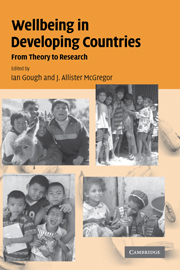Book contents
- Frontmatter
- Contents
- Figures
- Tables
- Notes on contributors
- Acronyms
- Preface
- Introduction
- 1 Theorising wellbeing in international development
- Part I Human needs and human wellbeing
- 2 Conceptualising human needs and wellbeing
- 3 Basic psychological needs: a self-determination theory perspective on the promotion of wellness across development and cultures
- 4 Measuring freedoms alongside wellbeing
- 5 Using security to indicate wellbeing
- 6 Towards a measure of non-economic wellbeing achievement
- Part II Resources, agency and meaning
- Part III Quality of life and subjective wellbeing
- Conclusion: researching wellbeing
- References
- Index
6 - Towards a measure of non-economic wellbeing achievement
Published online by Cambridge University Press: 22 September 2009
- Frontmatter
- Contents
- Figures
- Tables
- Notes on contributors
- Acronyms
- Preface
- Introduction
- 1 Theorising wellbeing in international development
- Part I Human needs and human wellbeing
- 2 Conceptualising human needs and wellbeing
- 3 Basic psychological needs: a self-determination theory perspective on the promotion of wellness across development and cultures
- 4 Measuring freedoms alongside wellbeing
- 5 Using security to indicate wellbeing
- 6 Towards a measure of non-economic wellbeing achievement
- Part II Resources, agency and meaning
- Part III Quality of life and subjective wellbeing
- Conclusion: researching wellbeing
- References
- Index
Summary
Introduction
It has become commonplace to treat wellbeing as a multidimensional concept, enveloping diverse, separable or behaviourally distinct components, domains or dimensions. Accordingly, a wide and growing range of national wellbeing achievement indicators now exists, with each intended to capture one or more of these dimensions. Indicators of health and education status are widely used and available for large samples of countries. Multidimensional indicators are also popular. The best known and most widely used multidimensional indicator is the Human Development Index (HDI), which is published annually and now available for more than 170 countries (UNDP 2004). These indicators, along with most of their counterparts, are often seen as alternatives to income per capita and are hoped to shed light on wellbeing achievement that economic indicators cannot. This is obviously consistent with a multidimensional conceptualisation of wellbeing: income per capita might be a valid indicator of achievement in a material or economic dimension of wellbeing, but not of achievement in others.
Yet as valid as the preceding case might sound, the commonly used or standard indicators of non-economic wellbeing achievement are often highly correlated, both ordinally and cardinally, among countries with income per capita. Inter-country variation in non-economic wellbeing achievement, measured using these standard measures, is, therefore, well predicted by variation in economic wellbeing.
- Type
- Chapter
- Information
- Wellbeing in Developing CountriesFrom Theory to Research, pp. 133 - 154Publisher: Cambridge University PressPrint publication year: 2007
- 3
- Cited by



